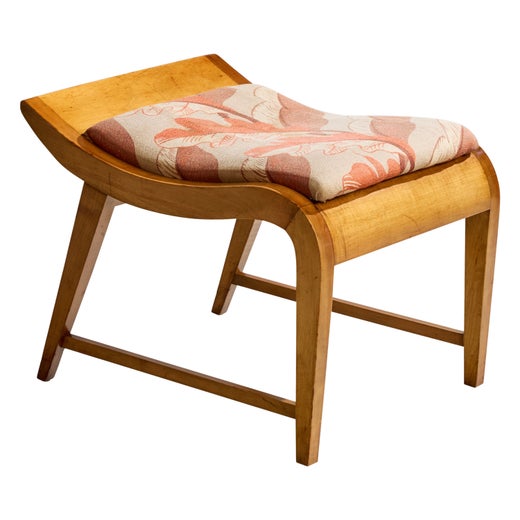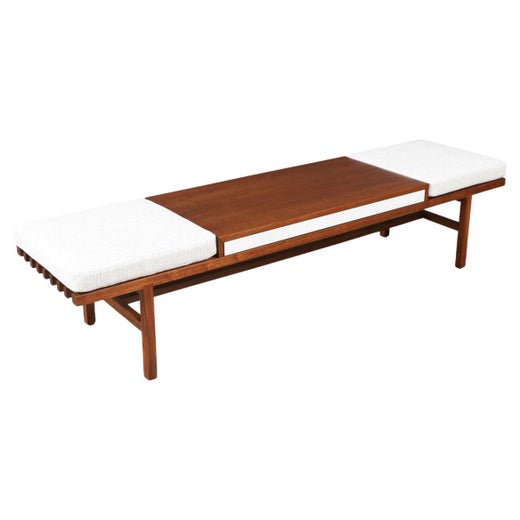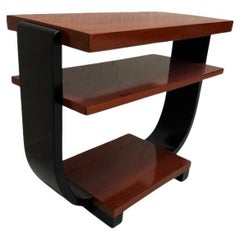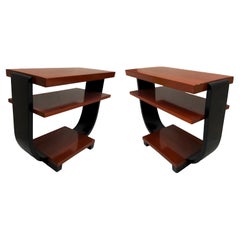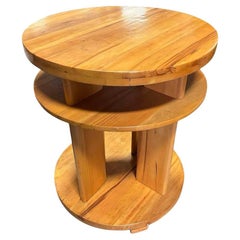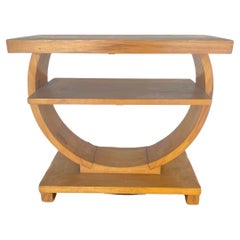Art Deco Two-Tone Geometric Side Table by Gilbert Rohde for Brown Saltman
About the Item
- Creator:Gilbert Rohde (Designer),Brown Saltman (Maker)
- Dimensions:Height: 22 in (55.88 cm)Width: 26.5 in (67.31 cm)Depth: 12 in (30.48 cm)
- Materials and Techniques:
- Place of Origin:
- Period:
- Date of Manufacture:1940
- Condition:excellent.
- Seller Location:Van Nuys, CA
- Reference Number:Seller: 20N01375.JI.4MS1stDibs: LU947439926972
Gilbert Rohde
Pioneering self-taught industrial designer, writer and teacher Gilbert Rohde helped define the earliest phase of modernism in the United States. He is one of the most influential figures of 20th-century design and is credited with helping legendary mid-century modern furniture manufacturer Herman Miller avert financial disaster during the Great Depression.
Born in New York City, Rohde studied painting at the Art Students League after high school. He found lucrative employment, first as a political cartoonist and then as a catalog illustrator for American department stores. He was particularly enthralled with drawing furnished interiors.
Rohde began to design furniture in his spare time. He traveled to the Bauhaus school in Germany and the International Exhibition of Modern Decorative and Industrial Arts in Paris, and drew on the Art Deco movement and the work of designers such as Émile-Jacques Ruhlmann in his early pieces. Rohde opened his own studio in 1929 and secured private and commercial commissions. His clients would come to include formidable furniture makers Heywood-Wakefield and Troy Sunshade, and his innovative bentwood furnishings for them were practical and intended for the modern consumer.
In 1930, Rohde met Herman Miller founder D.J. De Pree in the company’s Michigan showroom during a business trip. By then, Rohde had a long list of prominent clients and his furniture had been exhibited in museums and galleries. Herman Miller was weathering a devastating slowdown in business, and the American furniture industry had generally been hit hard by the Great Depression.
Rohde boldly informed De Pree that the brand’s furniture had become outdated, which was part of the reason the company was in financial jeopardy. Homes had become smaller and could no longer accommodate the large Gothic– and Victorian–style furnishings and traditional reproductions of period bedroom suites that Herman Miller was offering at the time, Rohde explained.
Rohde secured a contract to design for the Michigan manufacturer. He championed the use of exotic woods and tubular steel, and created streamlined, unadorned bedroom furniture for Herman Miller — collections that included convenient vanities, which were unconventional pieces for De Pree’s company back then.
In 1933, Rohde oversaw the design of two bedrooms featuring sleek Herman Miller furniture — including innovative storage pieces he designed — as part of an International–style exhibit at the 1933 Chicago World’s Fair. The installation garnered acclaim for De Pree’s brand all over the world and afforded Rohde the opportunity to execute on his visionary ideas in front of a global audience. Rohde later designed lighting, seating and more for Herman Miller and was extensively involved in the company's marketing strategy and other areas of the business.
In 1942, Herman Miller, anticipating a postwar economic boom, began to produce office furniture for the first time, but its legacy is in the home. Working with legendary designers such as Ray and Charles Eames, Isamu Noguchi and Alexander Girard, the manufacturer fostered some of the boldest expressions of what we now call mid-century modern style.
Find vintage Gilbert Rohde coffee tables, lounge chairs, table lamps and other items on 1stDibs.
Brown Saltman
The enduring modern design legacy of Brown Saltman was born from the collaboration between designer Paul Frankl and furniture manufacturer David Saltman. Together, they created stunning mid-century modern solid wood furniture with Art Deco influences. Brown Saltman side tables, cocktail tables and credenzas are known for their thoughtful designs and exquisite details.
Frankl was a leading American designer who came to prominence in the 1930s by making rattan furniture for Hollywood stars. However, he dreamed of bringing his designs to the public. That chance came in 1939, when he met Saltman at a party. Saltman was the head of the Los Angeles-based Brown Saltman, which, at the time, specialized in furniture reproductions.
He asked Frankl to create a furniture line, which was released in 1941. It was a hit, with sales exceeding expectations. Frankl quickly started work on a new line for mass production. It featured simplified designs and less expensive materials like combed wood and textured plywood. This line was even more successful, and Frankl started on a third.
In 1942, Frankl and Saltman signed an extended contract to continue their collaboration. However, Saltman died in a traffic accident the next day. World War II also brought Brown Saltman production to a standstill. After the war ended, Frankl decided not to renew his contract.
Brown Saltman partnered with many other designers over the years. A walnut sideboard by Van Keppel-Green for Brown Saltman was featured in the Museum of Modern Art’s 1950-51 Good Design exhibition. Architect and interior designer Paul Laszlo also designed a commercial furniture line for the company in the 1950s.
Brown Saltman dissolved in 1960, but its well-built and beautifully designed furniture remains in high demand today.
On 1stDibs, find vintage Brown Saltman tables, storage cabinets, seating and more.
You May Also Like
Vintage 1950s American Mid-Century Modern Side Tables
Maple
Vintage 1940s American Modern Side Tables
Brass
Vintage 1930s American Modern Night Stands
Walnut
Mid-20th Century American Art Deco End Tables
Wood
Vintage 1960s American Mid-Century Modern End Tables
Glass, Wood
Vintage 1950s American Mid-Century Modern Side Tables
Formica, Wood
Vintage 1970s American Mid-Century Modern Side Tables
Wood
Vintage 1960s Side Tables
Cast Stone
Vintage 1960s American Mid-Century Modern Side Tables
Mahogany
Vintage 1960s Mid-Century Modern Side Tables
Resin, Walnut
More From This Seller
View AllVintage 1940s American Art Deco Side Tables
Wood
Vintage 1930s American Art Deco End Tables
Wood
Vintage 1930s American Art Deco Side Tables
Walnut
Vintage 1940s Art Deco End Tables
Pearwood
Vintage 1940s American Mid-Century Modern Side Tables
Glass, Oak
Vintage 1930s American Art Deco Coffee and Cocktail Tables
Glass, Mahogany
